Argolis or the Argolid is one of the regional units of Greece. It is part of the region of Peloponnese, situated in the eastern part of the Peloponnese peninsula and part of the tripoint area of Argolis, Arcadia and Corinthia. Much of the territory of this region is situated in the Argolid Peninsula.
Most arable land lies in the central part of Argolis. Its primary agricultural resources are oranges and olives. Argolis has a coastline on the Saronic Gulf in the northeast and on the Argolic Gulf in the south and southeast. Notable mountains ranges are the Oligyrtos in the northwest, Lyrkeio and Ktenia in the west, and Arachnaio and Didymo in the east.In addition, Argolis,, which includes the city of Nafplio, is at the southern end of the Greek mainland and is a popular holiday destination. The majority of the crags are easily accessible, together with plenty of beaches and many archaeological interests. This is an ideal area to go rock climbing for families with children and for groups with different interests, as well as a dedicated rock climbing holiday.
The rock climbing around Nafplio and the Argolis region is all on excellent solid grey limestone. The majority of the routes are single pitch sport routes, though there are some trad routes as well. However all of the climbing areas are only partially developed, which means there is a massive opportunity to establish new routes in the area.
The Argolis area claims to receive over 3,000 hours of sunshine per year and is a popular holiday destination. It also means that it is possible to rock climb virtually all year round in the Argolis region, even in the hot summer months as some crags such as Didyma are at an altitude of over 1,000m. The only time of the year to avoid is February and March when it tends to be wet.
How to reach Argolis
The best way to get to the Argolis area is to fly into Athens and then hire a car and Argolis is then roughly 2.5 hours drive from the airport. Anyway you will need a car to visit the majority of the crags as they are spread out all over the Argolis peninsula, and the public transport is not very good.
In case you want to reach the area by public transport you have the following options:
- By Bus Get the KTEL from Athens with direction Nafplio city or Kranidi. For more info you can check the KTEL Argolis website.
- By BoatGet the “Flying Dolphin” boat with direction Ermioni. For more info you can check the Hellenic Seaways website.
Where to Stay
In Argolis the rock climbing areas are spread out over a relatively large area, which means having a car is necessary to visit a number of different crags. The best places to stay are either at Nafplion, Ermioni or the campsite in Thermisia. In Nafplio there are various hotels for all kind of budgets and in Ermioni there are more B&B type of accommodations.
Of course, there are plenty of houses that are rented our via Air B&B.
For the ones that would like to try wild camping, there is plenty of open space, and especially in Katafyki ravine. Though, the only inconvenience is there is no running water almost every season of the year.
Guidebooks and Online Info
Although there are not many detailed guidebooks about climbing in Argolis, there are two main ones that are very detailed and informative.
Bolt Products guidebook by Jim Titt

The first guidebook, was created by the personal that is responsible for almost all new crags in Argolis, Mr. J. Titt. He basically, discovered, first climbed and bolted almost all crags in Ermionida, such as Didima Crag, Katafyki ravine, Pillars of the Wind, Franchthi caves, Castle of Thermissia etc.
Bellow you can find the guidebook by J. Titt
Argolis Rock Climbing Guidebook

Another great guidebook that covers 10 climbing areas in Argolis region plus 2 bonus crags of Korinth and Akropolis near Athens. The 10 climbing areas in the Argolis are: Nafplio, Vivari, Ortholithi, Didimon, Didimon Hinterland, Frachti, Katafiki, Pillars of the Wind, Thermissia, and Methana. You can find this guide book on the link bellow:
Online Info about climbing in Argolis
In addition to the guidebooks, there are some online resources, where you can get more insight about the various crags in the Argolis regions. Some of the online sources are the following:
and of course, our very own Olympus Mountaineering Blog
Crags in Argolis region
- Anatoli Sector – Nafplio
- Neraki Sector – Nafplio
- Karathona Sector – Nafplio
- Acronafplia Sector – Nafplio
- Kondyli
- Didyma
- Pillars of the Wind
- Katafyki Ravine
- Thermisia Castle
- Caves of Frachti
- Mount Ortholithi
- Rock of Ages
Trad climbing in Argolis region
- Monsters of the Wind | Climbing the South-West Ridge of Mount Ortholithi
- Diaberis Pothos | Trad Climbing at the top of Profitis Elias – Asini
Climbing in Nafplio
Nafplio is located in a protected bay of the Argolic Gulf, just 1.5 hours by car from Athens. The crags of Nafplio are in fantastic seaside locations; for the most part, the cliffs are solid limestone featuring slightly overhanging red, yellow, and white rock. Nafplio itself is very lively, and its Old Town is a popular weekend destination teeming with quayside cafés, restaurants and hotels. Thanks to Nafplio’s location and layout, you can easily navigate it on foot, and go climbing, jogging or swimming within minutes. Lastly, Nafplio has a very mild climate, which makes it one of the best venues in Greece for winter rock climbing.
Read detailed guide about climbing in Nafplio here:
There are the following sectors around Nafplio city
- Sector Anatoli
- Sector Neraki
- Sector Karathona
- Sector Acronafplia
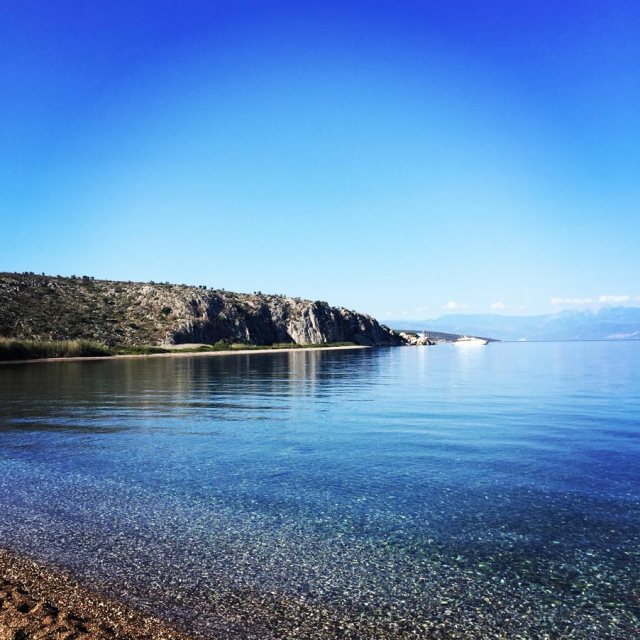
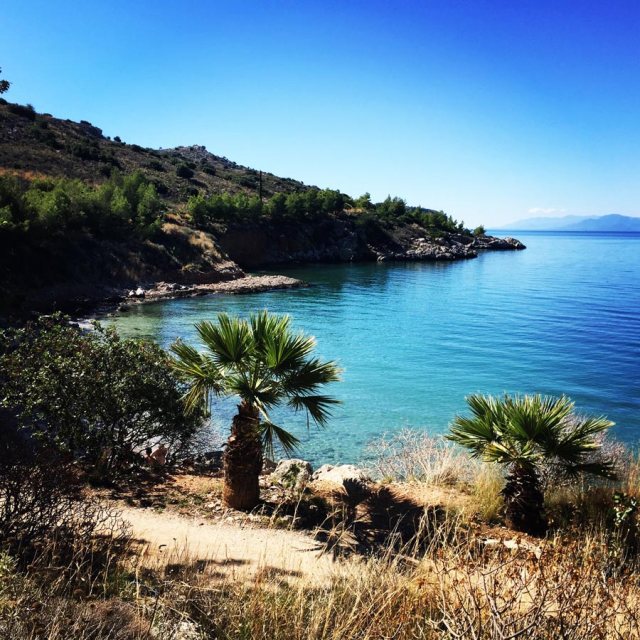
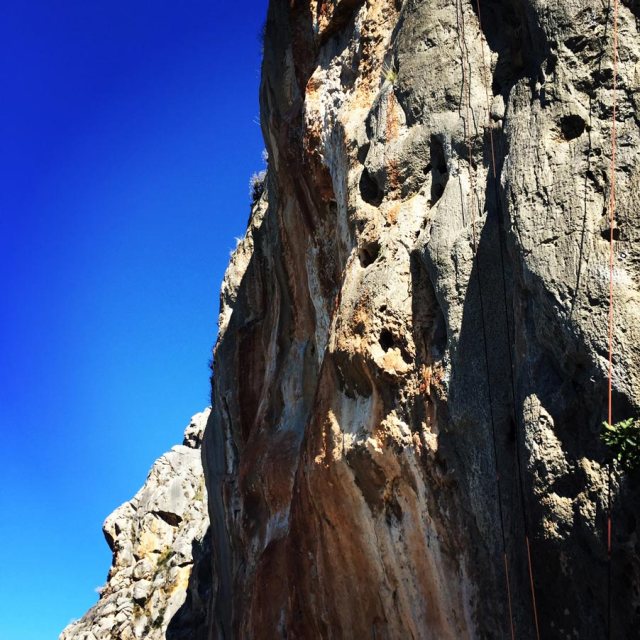
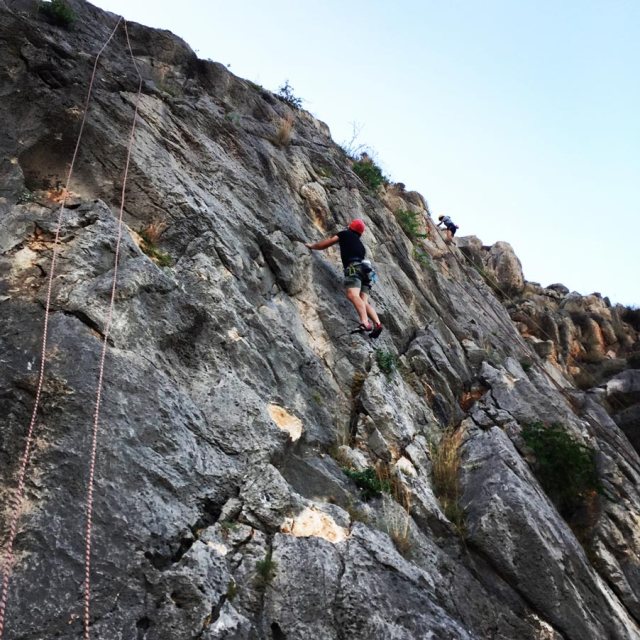
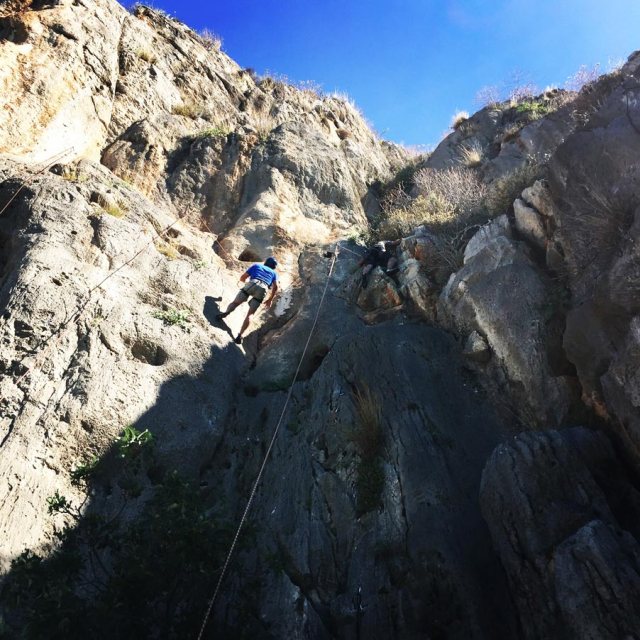
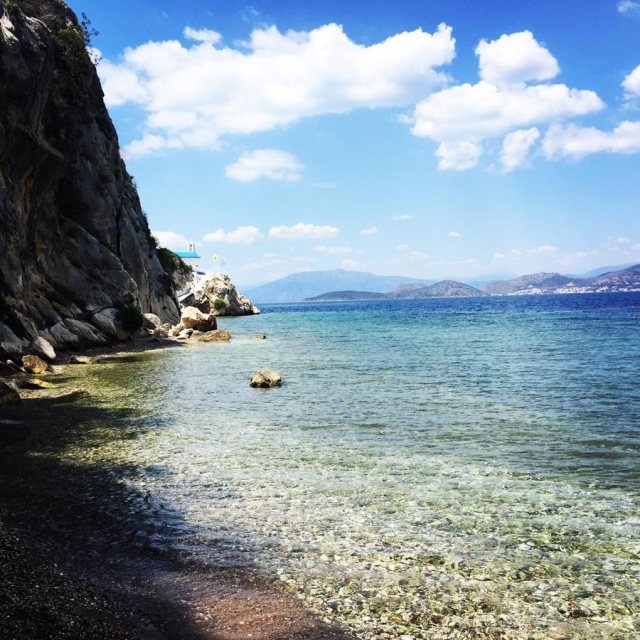
Climbing in Didima
The Didima climbing crag, is one of the top sports cliff in Greece. Excellent access, superb rock, magnificent views, great routes and a perfect climate for climbing on the hot summer afternoons make this the most popular cliff by far.
The cliff lies at the summit of the mountain of the same name and owing to its altitude 1.100m is around 10°C cooler than on the coast, and in the summer months is shaded after midday. Added to the cooling sea breeze this means that it is always agreeably cool.
The rock here is not as sharp as many areas allowing one to push the technical side, which is fortunate as the climbing is on steep or lightly overhanging walls and requires good technique. The cliff is divided into 2 sectors, Winter and Summer with sector Winter being less shaded, which is why there are no routes as yet on it!
Read detailed guide about climbing in Didima here:
This crag is family friendly and it has more than 70 routes. In addition, there are easy routes for beginners and more demanding routes for intermediate and advanced climbers. Almost all routes have been opened and bolted by J. Titt and I. Zaczek.







Climbing in Katafyki Ravine/Gorge
Katafyki gorge is a beautiful natural landscape, located between the villages of Fournoi and Ermioni. It consists of a protected area of outstanding beauty and a wild life refuge that attracts the most demanding visitors. Hikers can leave their car in Ermioni and take the path that passes through the dense vegetation of pines, laurels, myrtles, shrubs and other endemic plants. The sound of the running water and the presence of rare animals and wild birds give the impression of an earthly paradise. The imposing rough rocks host mysterious caves, one of which is said to consist of the entrance to the underworld, the point from where Hercules found Cerberus.
Read detailed guide about climbing in Katafyki here:
Parking directly under the cliff so no walk in! All year climbing as the main wall is shaded after midday. 45 routes here of which 7 are single pitch adventure routes,12 are multi pitch adventure up to 5 pitches 123m, 23 are single pitch sport routes and 3 are multi-pitch bolt routes up to 6 pitches 150m. All adventure routes have bolted belays and abseil pistes are equipped. Walk off o.k. in rockboots. Grades 4c to 7c+
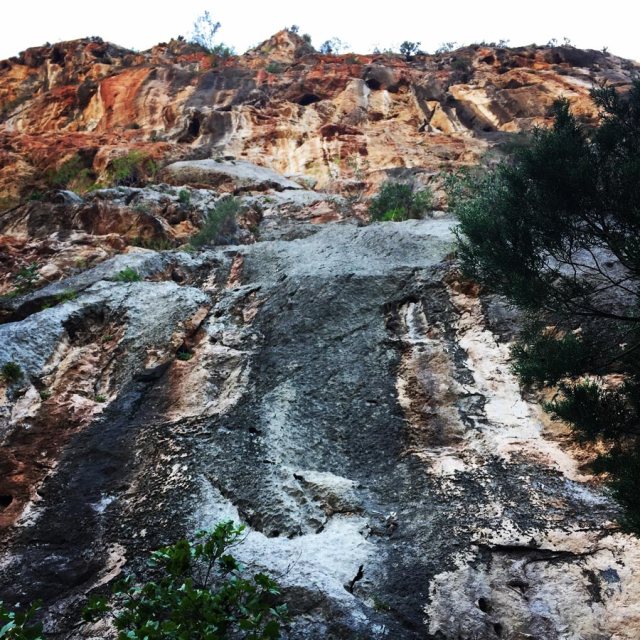
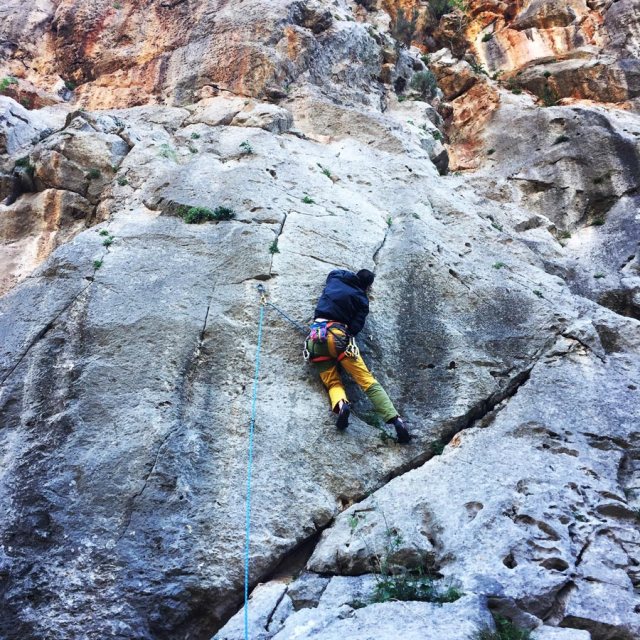
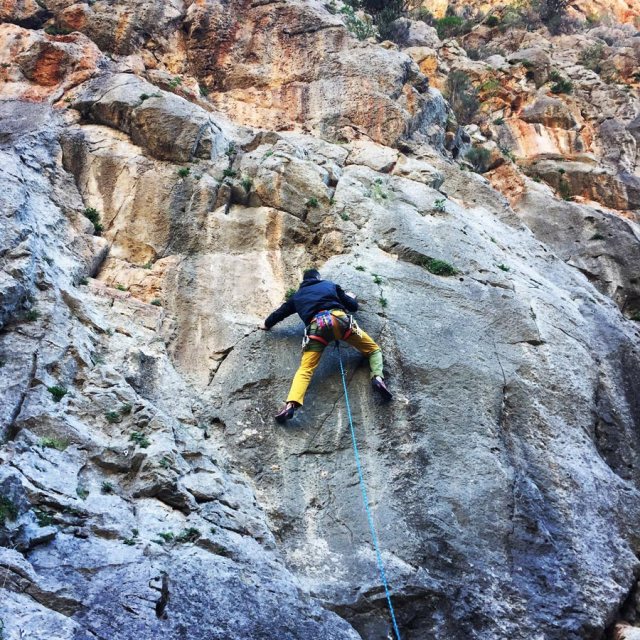


Climbing in the Castle of Thermisia (Kastro Thermisia)
An imposing cliff overlooking the coast and the village of Thermisia. Close inspection reveals an even more daunting prospect than a first view would suggest. Big, red, bulging and holdless seems to sum it up.
This is actually a great place to visit with a super view over the coast, a ruined castle to explore and a real classic climb, New Order which takes you up an unfeasibly overhanging wall at only 6a. The cliff is floodlit during the summer months and this would give a superb photo opportunity!
In my opinion the grades are somewhat downgraded, and the routes are often hard to start! At this point, I also have to pay respect to J. Titt that took care of almost all routes on this climbing crag.
Read detailed guide about climbing in the Castle of Thermisia here:
The castle of Thermisia appears in the written sources, as Trémis, for the first time in 1347, in the will of Gautier II de Brienne, Count of Lecce, de jure Duke of Athens, and de facto Lord of Argos and Nauplia. Surprisingly the castle is not referred to in a list of frankish castles in Greece dating from 1377. After his death, his possessions passed to Guy d’Enghien, son of Isabella de Brienne, Gautier’s sister. The daughter of Guy, Maria, after the death of her husband Pietro Cornaro, in 1388 sold her possessions to Venice for the sum of 500 ducats per year as long as she lived. Before the Venetians had the chance to settle in, it was occupied by the Despot of Mistra, Theodore Palaiologos.
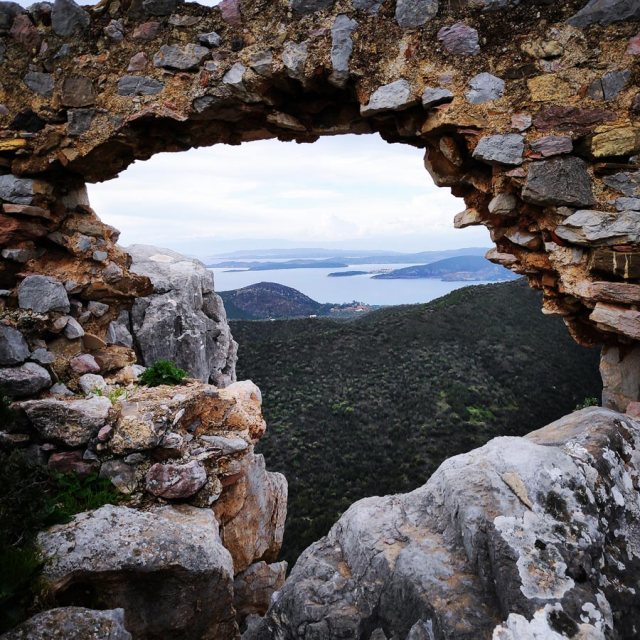

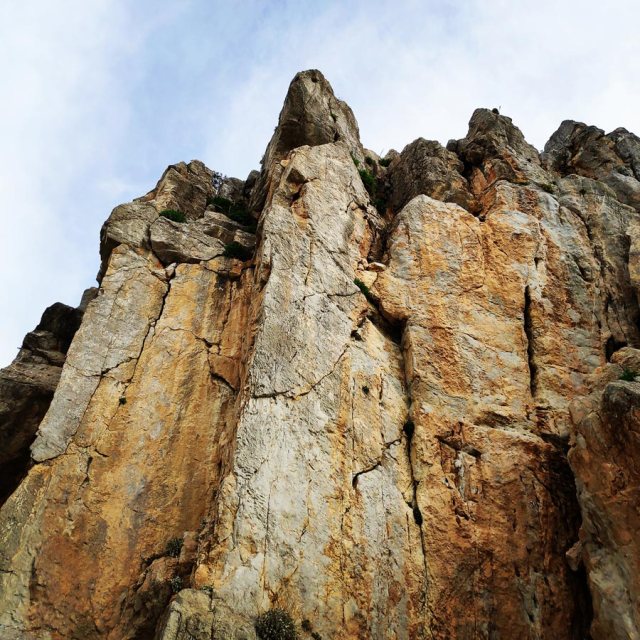
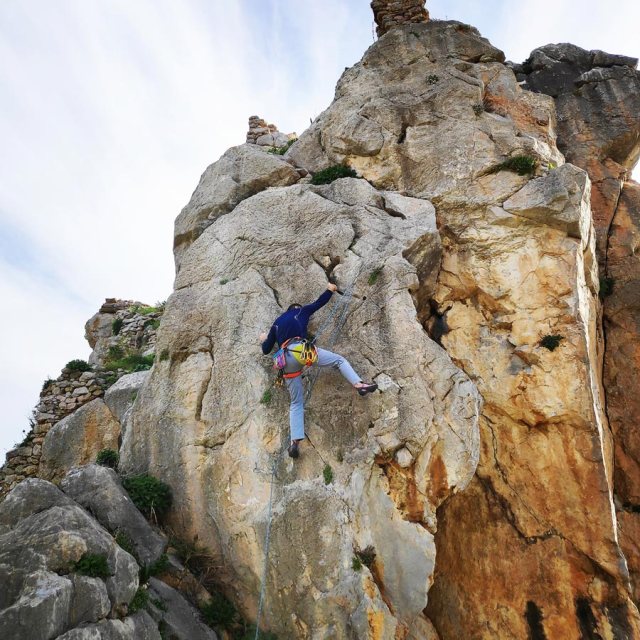

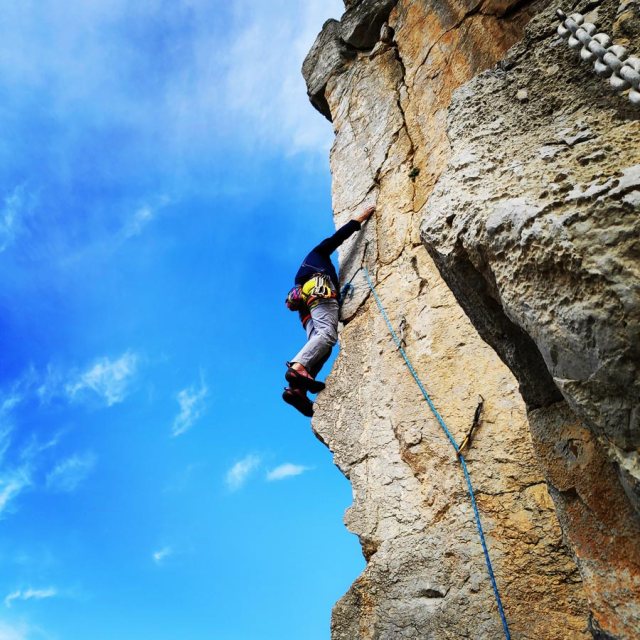


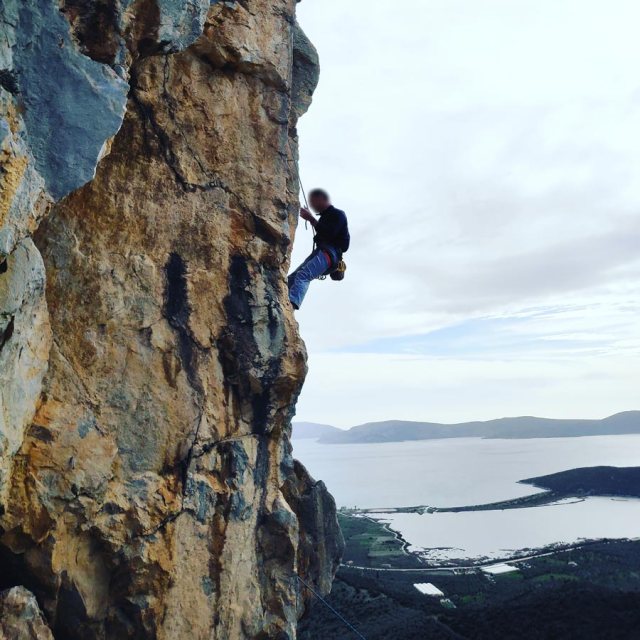
Climbing in the Pillars of the Wind
Pillars of the Wind, is an interesting rock formation giving the impression that a giant hand has thrust a lump of rock through the surrounding soil leaving shattered pinnacles and crazily leaning giant boulders. Very reminiscent of a Dartmoor for except it is made of limestone.
Pillars of the Wind is a very friendly venue with good access, a good variety of routes and great quality rock.
Read detailed guide about climbing in the Pillars of the Wind here:
This is a limestone inclusion in an area of volcanic activity and is like a miniature mountain peak with lots of shattered pinnacles. From above it doesn’t seem to offer much but the good climbing is on the east and south sides. Some of the rock at the top can be loose but otherwise is excellent. Try to take care if you stray off route. A crag with a friendlier ambience than most, and wonderful views, a deservedly popular venue for family groups as it is very child-friendly with a special top-rope area for the kids.
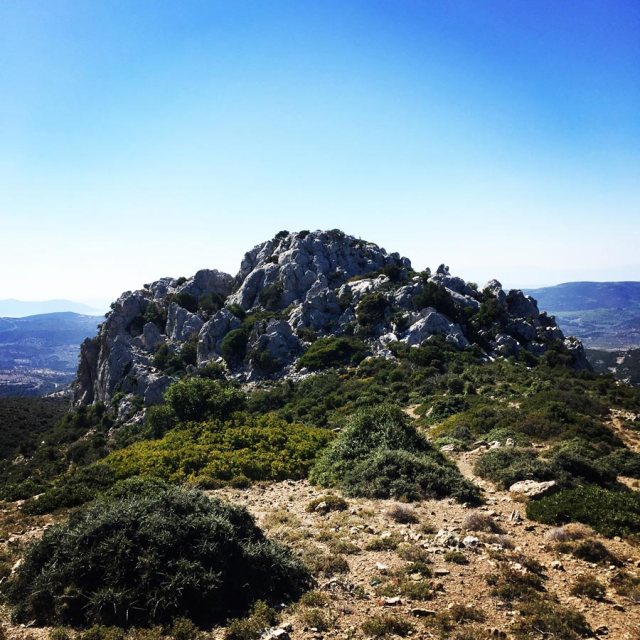
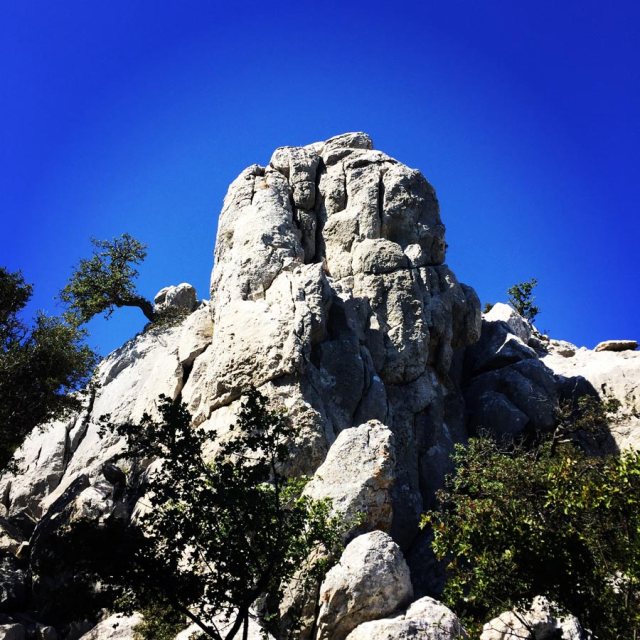

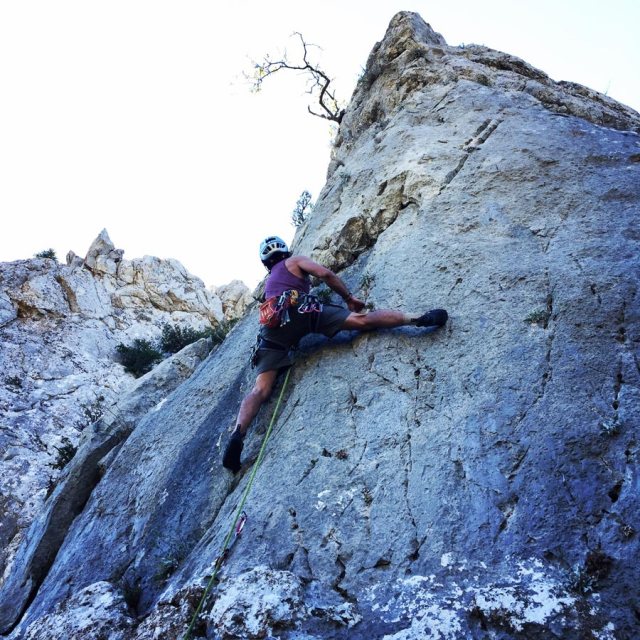
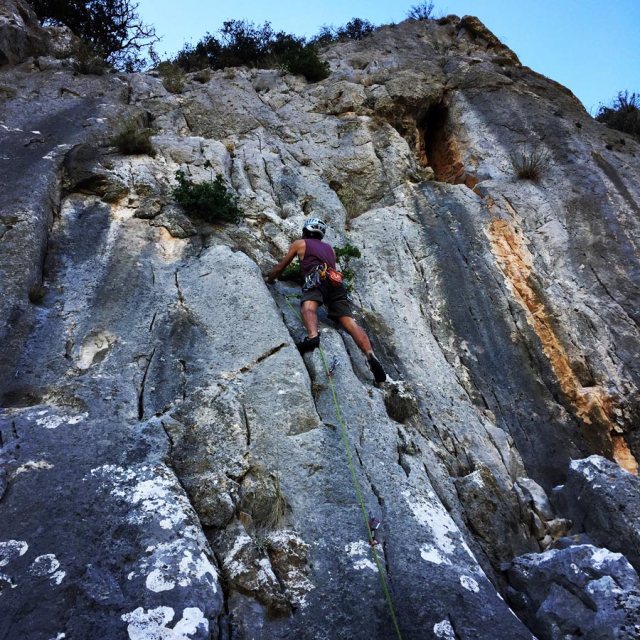
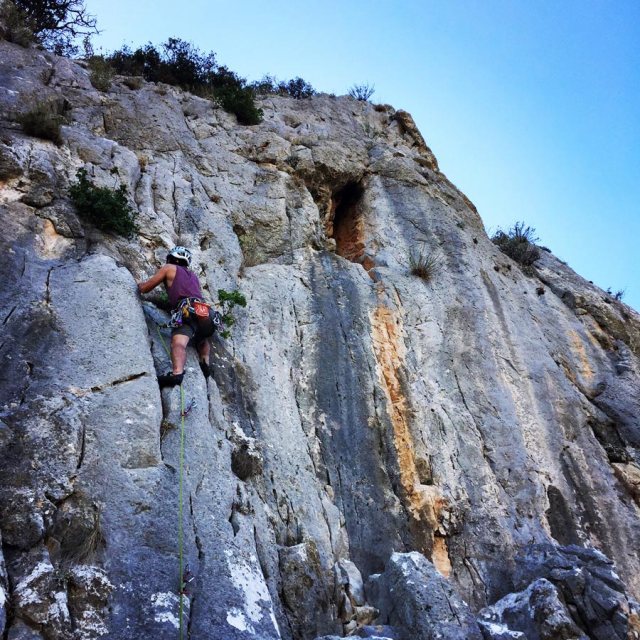
Climbing in the Caves of Franchthi
Franchthi cave or Frankhthi cave (Greek: Σπήλαιον Φράγχθη) is a cave overlooking the Argolic Gulf opposite the village of Koilada in southeastern Argolis, Greece. The cave was occupied from the Upper Paleolithic circa 38,000 BCE (and possibly earlier through the Mesolithic and Neolithic periods, with occasional short episodes of apparent abandonment. Last occupied around 3,000 BCE (Final Neolithic), it is one of the very few settlements in the world that shows nearly continuous human occupation for such an extended period of time, and is one of the most thoroughly studied sites from the stone age in southeastern Europe.
Read detailed guide about climbing in the Caves of Franchthi here:
An enormous series of caverns just above the sea, with large openings allowing enough light to climb by. At night the area is illuminated giving a superb climbing experience. Apart from being worth a visit in their own right some of the climbing here is outstanding and naturally, when it is raining, this is the place to be with some entertaining and bizarre climbing in the 20m deep crevasses under the floor. The potential for enormous roof climbs is obvious but hardly tapped. Karsten Oelze has shown the way with his recent efforts, but there is plenty more to do.
Outside the cave on the cliffs above the beach are 8 routes which we have cleaned and partly drilled but not yet bolted. With a few nuts or a toprope they give some good sport in the lower grades. The highpoint of a visit here are the routes in sector Last Exit, grade 6 climbing at its best.

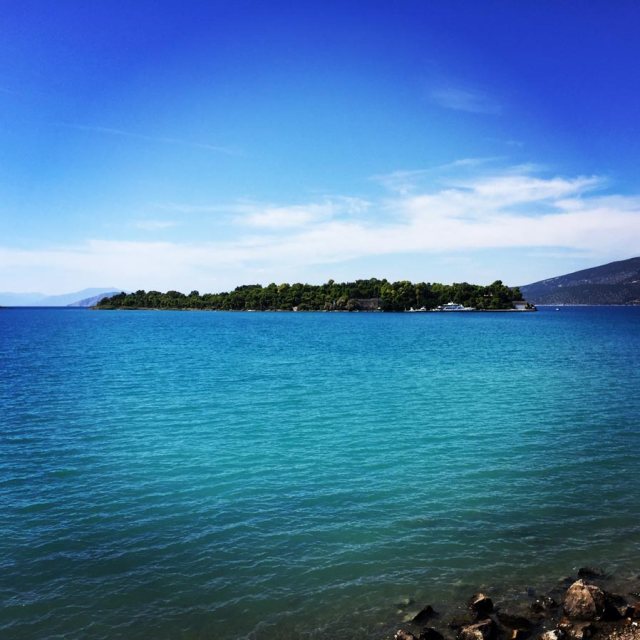
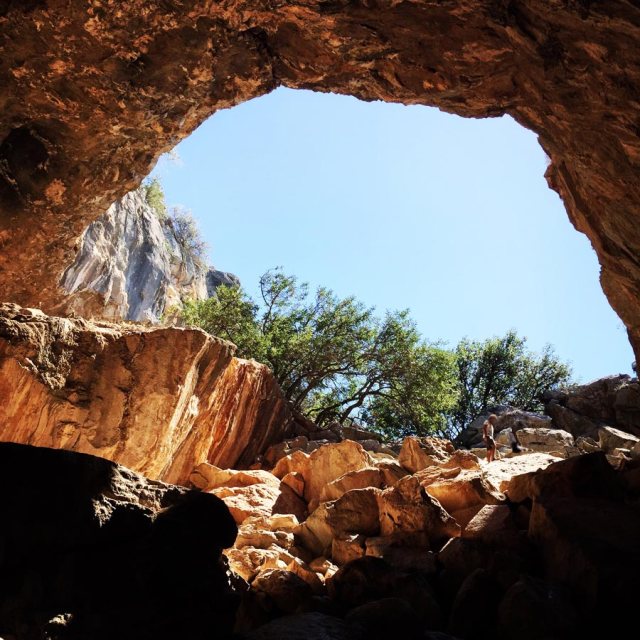



Climbing in Rock of Ages
A nice little cliff in a pleasant setting this is a small ravine with, by our standards, lush vegetation, trees and some good, if rather different, climbing.
One of the few cliffs in the Argolis that offers easy tufa climbs with the continuously overhanging Mr Cool at 5c being one the highlights, albeit a rather strenuous one! Other highly enjoyable if rather unusual routes include Dance With Monsters and the weird Pull Of The Sun which climbs up inside the cleft splitting the cliff, a real expedition.
The first sector, The Seven Dwarves has seven mini routes which are normally shaded, sector Fairy Tale has some medium length routes which tend to require more arm strength than is usual in Argolis. The main wall offers routes up to 30m with room for another 4 or 5. In the surrounding valleys are plenty of cliffs offering the chance to put up about a thousand new routes. An excellent cliff for chidren to play at the base in the shade of the trees, but only a few routes for them to top rope.
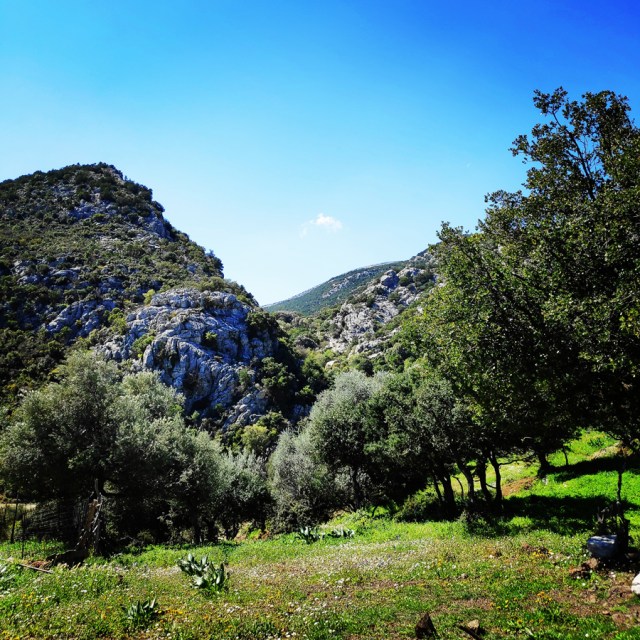
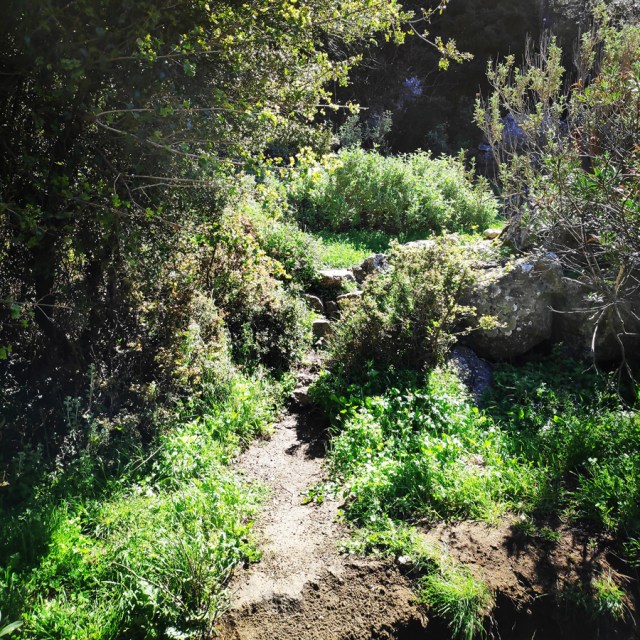
Access: Follow the route from Athens to Kranidi and go towards the village of Karantzas. from there, follow the map bellow:
Season: All year but in the winter there can be a cold wind here. In summer there is always some shade but the main wall is in the sun after about 12 o’clock.
Water: There is a spring higher up the ravine that the goats use.
Camping: A great spot in the trees at the foot of sector Seven Dwarves, otherwise anywhere in the hundreds of square km of mountain.



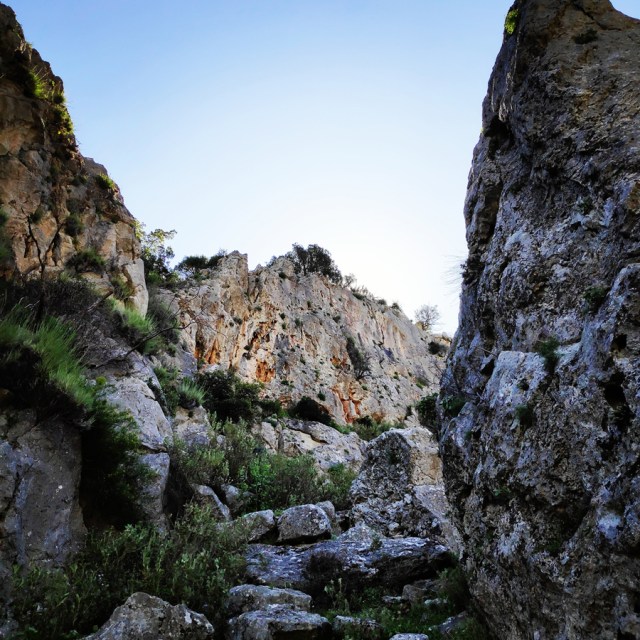

Monsters of the Wind | Climbing the South-West Ridge of Mount Ortholithi
“Monsters of the Wind” (IV+/V-, 500 m.) follows the south-western ridge of Mount Ortholithi, offering an atmospheric climb overlooking the Saronic Gulf and Ermionida. The route can be described as an “adventure route” with great potential for free route selection. The route also does not present any difficulties in terms of safety with the use of temporary protection.

Read detailed guide about climbing the “Monsters of the Wind” route here:
Approach
From Athens one needs to drive towards Epidavros and from there should follow the road to Ermionida. Just after Trachia village, should follow the road to Karatzas village and from there to Choriza.
Total distance from Athens: 150 km
About 2 km before arriving in Choriza ( 37.520145, 23.233478 ), there is a dirt road where we can leave the car and start the approach hike.
The approach hike is an easy hike of about 10 minutes.

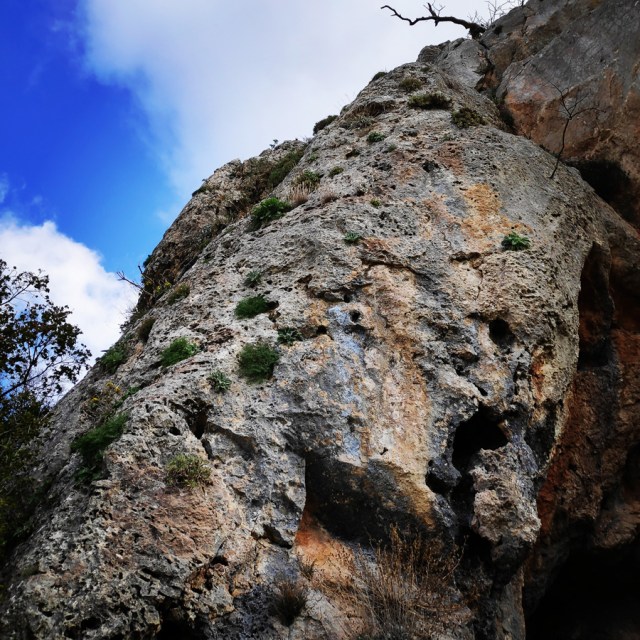

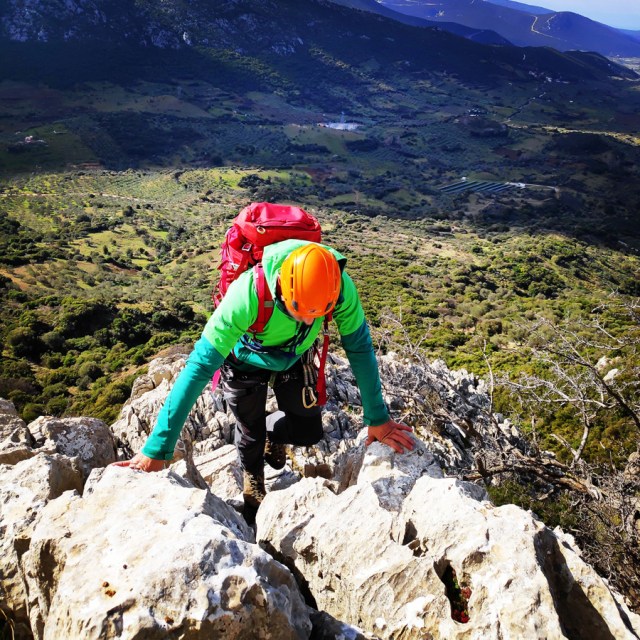
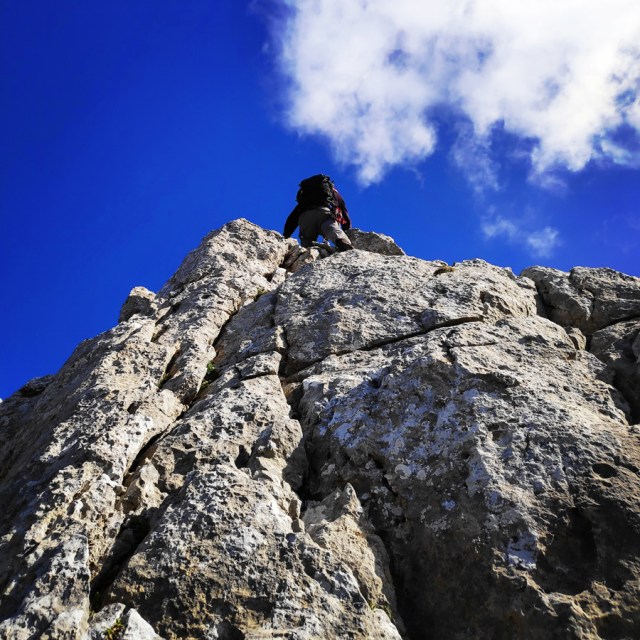

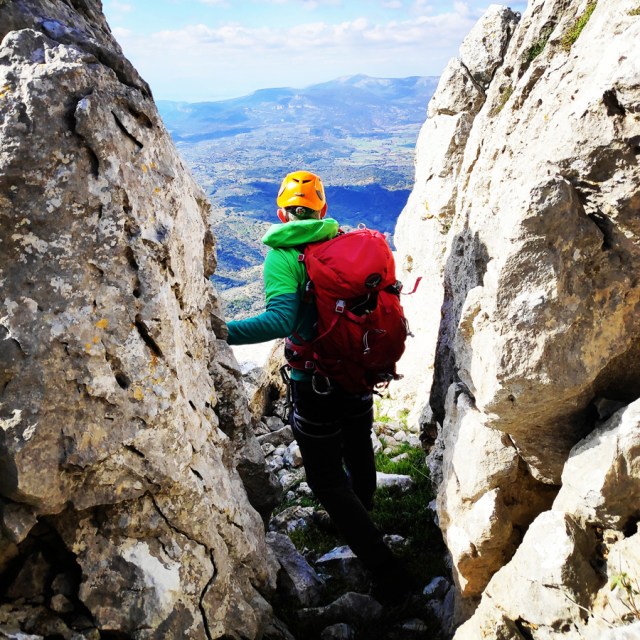
Diaberis Pothos VI UIAA 100 m. – First Ascent of the North-East couloir – Profitis Elias of Asini
“Diaberis Pothos” (VI, 100 m.) first ascent was made on 14/07/2020 by Christos Rigas and Olympus Mountaineering. The route follows the north-east couloir which is located on the north face of Profitis Elias Rock/hill. The route can be described as a “demanding route” with plenty of variety in the climbing style, from slab to dehydral and some scrambling too.
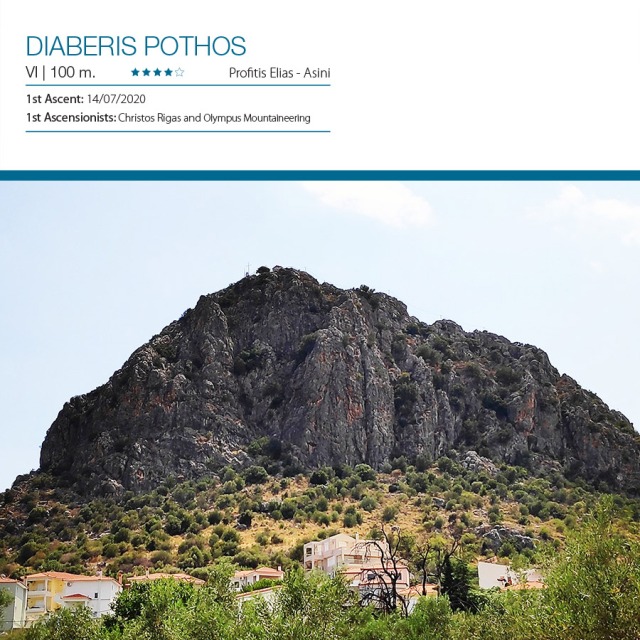
Read detailed guide about climbing the “Diaberis Pothos” route here:
Approach
From Nafplio follow Leoforos Asklipiou and then follow the road to Tolo and Asini. Just before Asini, turn right to Agia Paraskevi. Once in Agia Paraskevi, follow the signs to Profitis Elias and about 150 meters before the trail (Stairs) to the Profitis Elias Chappel, you can park your car on the side of a dirt road.
- Parking lot location: 37.546691, 22.853306
- Beginning of the route: 37.545420, 22.855434
Approaching the R0 requires 15 minutes of hiking and there is not an obvious trail. Best advice is to follow a large tube that is providing electricity to huge projector lights.


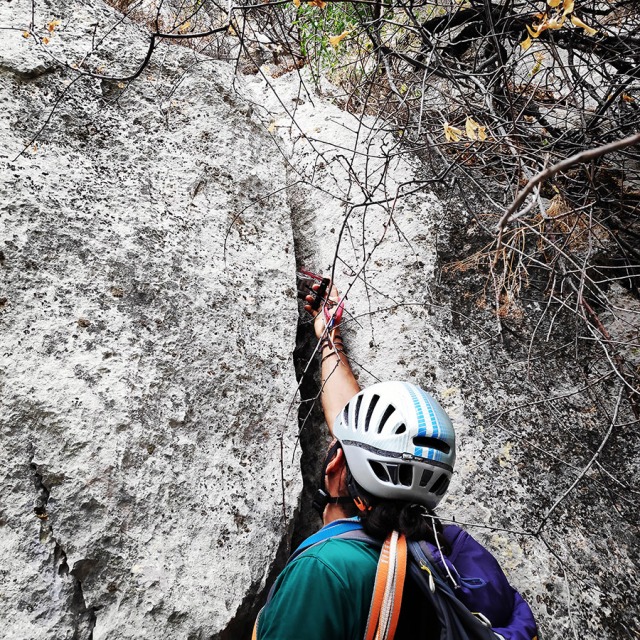

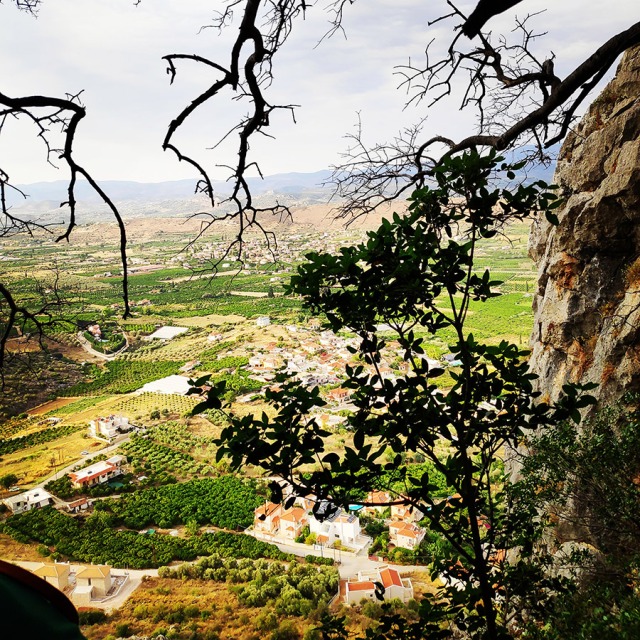


Crags in Argolis region
- Anatoli Sector – Nafplio
- Neraki Sector – Nafplio
- Karathona Sector – Nafplio
- Acronafplia Sector – Nafplio
- Kondyli
- Didyma
- Pillars of the Wind
- Katafyki Ravine
- Thermisia Castle
- Caves of Frachti
- Mount Ortholithi
- Rock of Ages
Trad climbing in Argolis region
- Monsters of the Wind | Climbing the South-West Ridge of Mount Ortholithi
- Diaberis Pothos | Trad Climbing at the top of Profitis Elias – Asini
Further Information
This post contains many information regarding the various crags and sectors in the Argolis region. Should you wish to know more and your have a specific question, we would be pleased to try to help you out.
You can contact us, via the contact page.
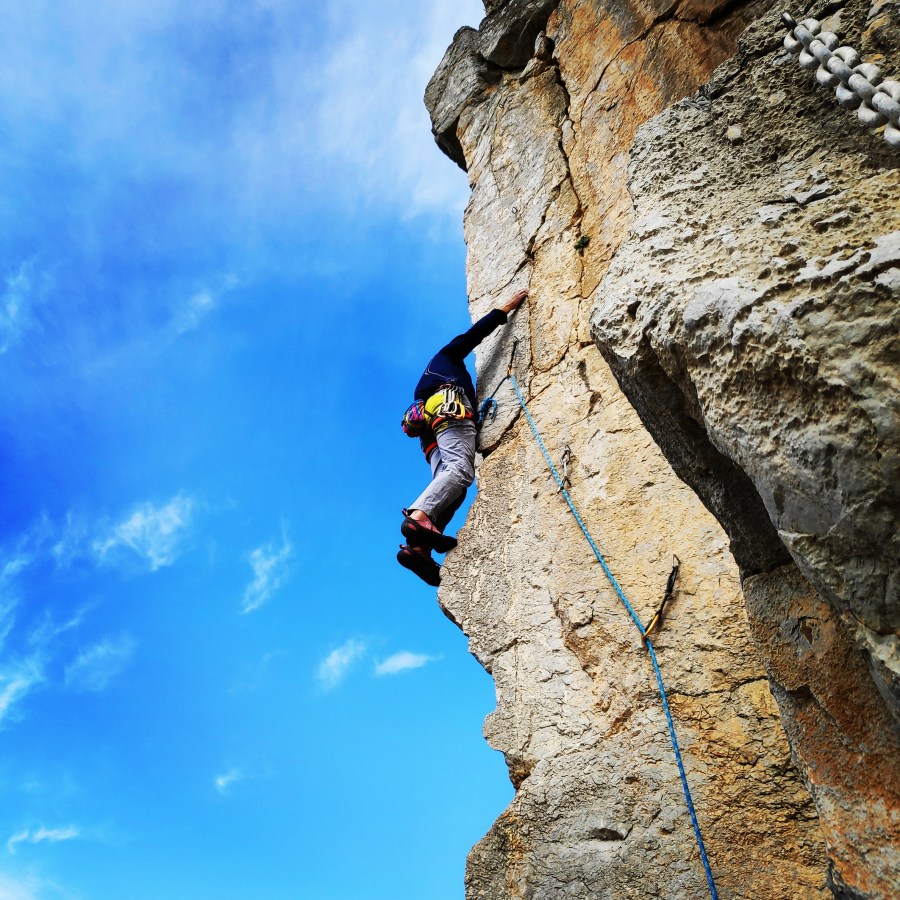
Pingback: Climbing the South-West Ridge of Mount Ortholithi – Olympus Mountaineering
Pingback: Climbing in Dardiza – Ermioni – Argolis | Greece – Olympus Mountaineering
Pingback: The Ultimate Guide of Climbing in Ermionida, Argolis – Greece – Olympus Mountaineering
Pingback: Climbing in Franchthi Caves – Ermionida, Argolis – Olympus Mountaineering
I am looking for a human climbing guide in the Peloponnese for late September, for one-on-one climbing, full days, 5c to 6a+. Can you help me?
LikeLike
Hi there and thank you for getting in touch with the blog.
Please, use the contact form and send an email, and I can surely hook you up with a professional guide.
LikeLike